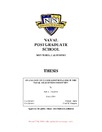A Cost Benefit Analysis of Fire Scout Vertical Takeoff and Landing Tactical Unmanned Aerial Vehicle (VTUAV) Operator Alternatives
| dc.contributor.advisor | Hatch, Bill | |
| dc.contributor.author | Heiss, Kevin L. | |
| dc.date | Mar-12 | |
| dc.date.accessioned | 2012-05-14T18:55:48Z | |
| dc.date.available | 2012-05-14T18:55:48Z | |
| dc.date.issued | 2012-03 | |
| dc.identifier.uri | https://hdl.handle.net/10945/6806 | |
| dc.description.abstract | A cultural debate exists to determine if the MQ-8B Fire Scout Vertical Takeoff and Landing Tactical Unmanned Aerial Vehicle (VTUAV) should be operated by rated pilots, commissioned officers, or enlisted personnel. Each military service has historically treated this issue differently. The U.S. Navy currently requires rated pilots to fly Fire Scout, the U.S. Army and Marine Corps allow enlisted personnel to fly their Shadow Unmanned Aerial Vehicle (UAV), and the Air Force only allows rated pilots to fly their UAV systems. Technology has advanced rapidly in the area of UAVs as they have advanced from being remotely piloted aircraft to now being completely autonomous. This research examined the Air Vehicle Operator (AVO) requirements for autonomous vehicles such as Fire Scout and will demonstrate that the U.S Navy should create a pilot program that trains enlisted personnel to operate Fire Scout. This research identifies the costs and benefits associated with each type of prospective operator alternativerated pilots, commissioned Surface Warfare Officers (SWO), and Operations Specialist (OS) enlisted personnel. By utilizing enlisted AVOs vice rated pilots, training costs will be found to be reduced from millions to tens of thousands, annual amortized manning costs will be cut by more than half, and total cost savings will be found to be on the order of a billion dollars over a ten-year period. The research will also identify both tangible and intangible benefits by allowing enlisted personnel to become Fire Scout AVOs. Benefits are identified relating to training time, manning constraints, physiological constraints, culture, and safety. Furthermore, this research will summarize current Knowledge, Skills, and Abilities (KSA) necessary to operate an autonomous air vehicle such as Fire Scout. | en_US |
| dc.description.uri | http://archive.org/details/acostbenefitanal109456806 | |
| dc.publisher | Monterey, California. Naval Postgraduate School | en_US |
| dc.title | A Cost Benefit Analysis of Fire Scout Vertical Takeoff and Landing Tactical Unmanned Aerial Vehicle (VTUAV) Operator Alternatives | en_US |
| dc.type | Thesis | en_US |
| dc.contributor.secondreader | Roberts, Ben | |
| dc.contributor.department | Management | |
| dc.subject.author | Fire Scout VTUAV | en_US |
| dc.subject.author | Air Vehicle Operator (AVO) | en_US |
| dc.subject.author | Mission Payload Operator (MPO) | en_US |
| dc.subject.author | Intelligence Surveillance Reconnaissance (ISR) | en_US |
| dc.subject.author | Unmanned Aerial Vehicle (UAV) Unmanned Aerial System (UAS) | en_US |
| dc.subject.author | Human Resources Cost Analysis Tool (HRCAT) | en_US |
| dc.description.service | Commander, United States Navy | en_US |
| etd.thesisdegree.name | Master of Science In Management | en_US |
| etd.thesisdegree.level | Masters | en_US |
| etd.thesisdegree.discipline | Management | en_US |
| etd.thesisdegree.grantor | Naval Postgraduate School | en_US |
Files in this item
This item appears in the following Collection(s)
-
1. Thesis and Dissertation Collection, all items
Publicly releasable NPS Theses, Dissertations, MBA Professional Reports, Joint Applied Projects, Systems Engineering Project Reports and other NPS degree-earning written works.





